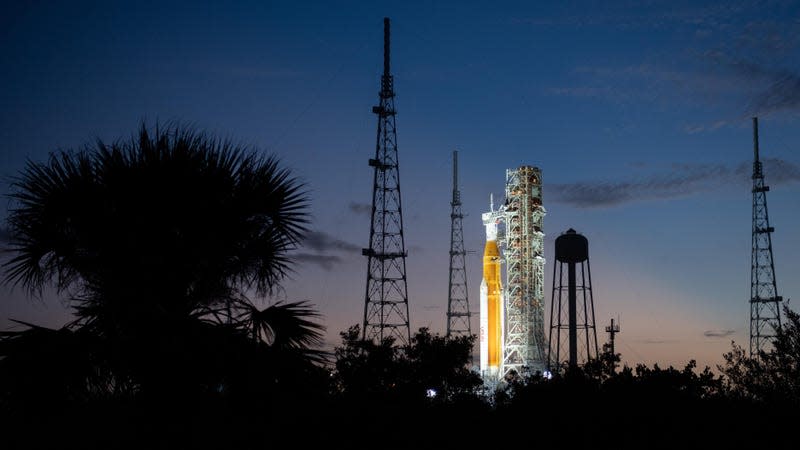NASA's Moon Rocket Endures Excessive Winds on Its Launchpad in Florida

Tropical Storm Nicole made landfall as a hurricane early Thursday morning, unleashing strong winds on NASA’s Kennedy Space Center (KSC) where the Space Launch System (SLS) rocket was left stranded on the launchpad.
In anticipation of the storm, NASA further delayed the launch of the SLS rocket for its Artemis 1 mission to the Moon. Instead of taking off on November 14, the rocket’s liftoff was delayed to no earlier than November 16 “pending safe conditions for employees to return to work, as well as inspections after the storm has passed,” NASA wrote in a blog. However, rather than rolling the SLS rocket back to the nearby Vehicle Assembly Building for shelter, the space agency opted to keep it on the launchpad to weather the storm.
Read more
“There was a risk in leaving it on the pad, but there was another risk if they had rolled it back, since the act of moving it causes swaying and mechanical loading of the vehicle, too,” Philip Metzger, a planetary scientist at the University of Central Florida, who used to work at NASA’s KSC, told Gizmodo in an email. “Either way, the vehicle would be stressed, so NASA was forced into placing a bet whether one choice or the other would cause less strain.”
The space agency’s 322-foot-tall (98-meter) rocket is designed to withstand winds reaching 85 miles per hour (137 kilometers per hour). However, weather sensors on the launch complex recorded maximum winds reaching 100 miles per hour around 4 a.m. ET, with an average of 85 miles per hour, according to data gathered by NASA. These winds could compromise the structure of the rocket. That’s because rockets are designed to endure intense winds going upwards, rather than wind pressure horizontally.
But still, the winds from the storm may not have been strong enough to affect SLS. “I am hearing that NASA believes there is plenty of structural margin in the design of the rocket, so the winds from hurricane Nicole did not create a risk to launch,” Metzger said.
However, even if SLS is still intact, NASA may have to wait for clearance to launch given that the rocket was exposed to intense winds. “They did violate the vehicle’s wind-load requirements, so NASA will still need to go through a formal process to certify their analysis before launch,” Metzger added.
The space agency will also need to do inspections at the pad to assess the status of the rocket, and may later need to get approval from a program control board that needs to evaluate the data before giving the go-ahead for launch, according to Metzger.
Hopefully the rocket’s latest brush with Nicole won’t push back its launch even further as the Artemis 1 mission has already suffered several delays. The mission’s original launch date was slated for August 29, but many of its launch attempts have been called off. The Artemis 1 mission will eventually see the launch of the SLS rocket for the first time, sending an uncrewed Orion on a 25-day mission around the Moon and back. The mission is the kickoff to NASA’s Artemis program, designed to land humans on the Moon no earlier than 2025.
More: NASA Recovers Inflatable Heat Shield From Pacific Ocean After Orbital Test
More from Gizmodo
The Best Shortcuts On Mac: Snap Windows, Text to Speech, and More
How to Delete Your Twitter Account If Elon Musk Was Your Last Straw
Sign up for Gizmodo's Newsletter. For the latest news, Facebook, Twitter and Instagram.

